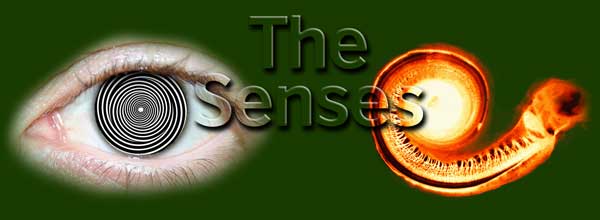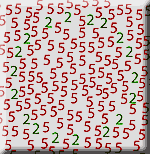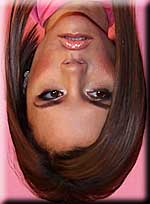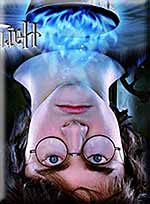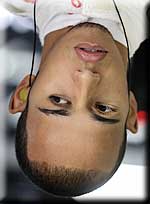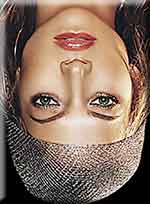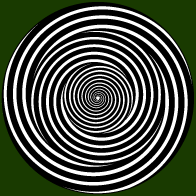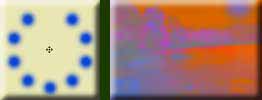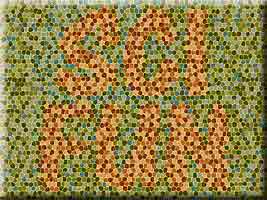Vision
The sections below provide more information on some of the topics covered in the Senses show. Click on the link above to switch between this page (on vision) and the page covering the hearing demonstrations.
Other visual illusions can be found on our Survival show page.
Experiment #1: Synaesthesia
Click the image or link below to visit our page with more information about the peculiar jumbling of the senses that is synaesthesia, as well as to try your luck with a variety of number-colour synaesthetic pictures.

Recognising the face
As we discussed in our show, several parts of the brain are responsible for the recognition of aspects of the face. The fusiform gyrus in the temporal lobe does, however, appear to be particularly important in facial perception.
In particular, the brain is exceptionally sensitive to small changes in the shapes of the eyes and mouth. This makes evolutionary sense for humans, since so much of our understanding of the emotional state of another person comes from detecting subtle changes in these parts of the face. Primates in general, and humans in particular, recognise not only individual faces, but also pick up important communication and emotional cues from the eyes and mouth (in particular the corners: see below).
We can show that the shapes of the eyes and mouth are overwhelmingly important with the upside-down face images below, a couple of which you'll have seen during the show.
Click on each image in turn, to see a larger version (and to see it the right way up).

Subtle clues, and da Vinci's genius?
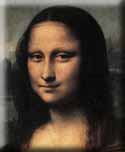 As we've described above, the corners of the eyes and mouth are particularly important in working out the emotions of the person we're looking at. These are high-spatial-frequency parts of the face, and the visual system appears to respond to extremely tiny changes in their state. As we've described above, the corners of the eyes and mouth are particularly important in working out the emotions of the person we're looking at. These are high-spatial-frequency parts of the face, and the visual system appears to respond to extremely tiny changes in their state.
If we take a picture of a face, and blur the corners of the eyes and mouth, people find it much more difficult to work out exactly what emotion the face is showing.
One possible example of this in art is the Mona Lisa, painted by Leonardo da Vinci, which has long been held to have an "ambiguous" expression, or 'mysterious smile'. If we examine the painting in detail, we can see that, after painting the face, da Vinci carefully smudged and blurred the corners of the woman's mouth and eyes! It would appear that he had great insight into what makes our visual centres tick...

Using illusions to understand the brain
Optical illusions are often fun to look at, but many of them have been designed (or discovered) to highlight the way in which the visual system works. A good example is the Tri-Zonal Space Warper (below), invented by magician Jerry Andrus in the mid-1970's, which illustrates a phenomenon known as the Waterfall Effect, an example of neural adaptation. You can click on the links below to download animated GIFs of the effect: for the larger versions you'll need to have a reasonably powerful graphics card, in order that the image rotates smoothly, without jerking. (The scalable image below is a mathematical set of curves based on a scan of my [Peter's] copy of the original space warper, which was published in OMNI magazine, way back...)
| Note: if the illusions below don't move when you click on them, it's because your browser is set to prevent animations from running. GIF files here store several images, which are loaded and then shown in sequence: with animation turned off, you'll see only the static first frame. To turn it on in Internet Explorer, select Tools/Internet Options/Advanced, then scroll to Multimedia, and turn on Play animations in web pages. (Animation should be on in Firefox: if not, type "about:config" as URL, double-click to "image.animation_mode", and type "normal".) |
|
|
|
The Tri-zonal Space Warper
Click below for animated GIFs in a variety of sizes:
small, medium, large
|
|
If you want to print a version, click here for a vector PDF, scalable to any size
|
Neural adaptation describes the way in which our senses respond to a continuous stimulus: in this case the movement of black and white edges in the same direction (or the continuous movement of water vertically downwards in a waterfall). As a stimulus continues, the sensory system reacts less and less strongly; in some types of response, it eventually stops reacting at all. Then, when the stimulus is removed, the senses can appear to perceive the opposite effect.In the case of the spirals in our show (and on the left), the part of your visual system which responds to movement becomes adapted to the continuous motion in one direction. Of course, in the case of the spirals, there are three regions: two spirals rotating inwards, and one spinning outwards.
Once you look away at, say, the back of your hand, your visual field sees (for ten seconds or so) movement in the opposite direction: parts of your hand seem to bulge outwards, and others to go inwards, giving a strange, rippling effect. (You'll notice that if you stop the spirals – hitting ESC will do that – they'll appear to spin back the other way, for a second or two.)

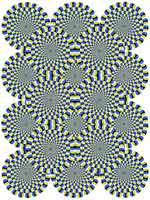 |
Click here or on the images opposite to see more visual illusions
|
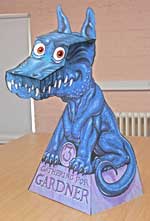 |

Colour adaptation: two amazing examples
|
|
Another example of adaptation occurs when you stare at a coloured image for a while, and the cone cells in your retina (which respond to colour) slowly adapt, and lose sensitivity. Then, when you look away from the image at a white surface, you see a 'negative', as the unaffected receptors continue to fire strongly. A couple of amazing examples of this can be seen if you click on the image on the left, and follow the instructions on the page. |

The World in Colour
|
Roses are red,
Violets are brown,
The sky is bright yellow
and so are bluetits.
Colour-blind poem, Monty Python
|
We couldn't spend much time during the show discussing colour-blindness, but (apart from the links below) we have some information on how you can create your own colour blindness test charts. You'll need access to a program such as Photoshop (or Illustrator), using which you can draw in specific colours, to create images such as the one below. Click on it (or the text) for more information.

Perception: the final film
Having looked briefly at the way in which the senses gather information from the outside world, and also at the ways in which regions of the brain process that information (and on ways in which both can be affected by damage or age), the final part of our show touches briefly on the ways in which we have to focus our attention on the information which has been gathered and processed.
Click here for the perception demonstrations...
You'll need to allow ActiveX controls in Internet Explorer, to run the password Javascript. In IE you may also have to click on an information bar, which will appear at the top of this browser window. (Look for the bar if a dialog box appears, claiming that you didn't enter a password...)
|

|
Useful Vision Links
|
|
These links give you more information on visual topics raised in the show.
|
| A web page with a short description of synaesthesia (plus links) |
|
Synaesthesia |
| These are links to pages written by people who are synaesthetic, and help todescribe how the condition actually feels. |
|
Carol
Karen
Cassidy
Christian |
| A site with more technical information on synaesthesia. |
|
Synaesthesia research at Sussex University |
| A series of tests for all sorts of synaesthesia, including number/word-colour charts. You have to register (free) with the site, but you can then try out a whole range of tests. |
|
The Synaesthesia Battery |
The BBC Reith Lecture 2003: "The Emerging Mind", covered a whole range of fascinating topics about the human brain. Each talk is about fifty minutes long, and the fourth lecture covers synaesthesia in detail.

|
|
Reith 2003: "The Emerging Mind" |
| A Scientific American article by one of the pioneers in synaesthesia research, Vilayanur S. Ramachandran. |
|
"Hearing colours, tasting shapes" |
| An interesting article on synaesthesia |
|
Yale Scientific |
"Neuroscience for Kids": a website with lots of information on all aspects of brain and nervous system function. Scroll down the page to find a link to more information on vision and synaesthesia.
 |
|
Neuroscience for Kids |
| University of Illinois' Visual Cognition Lab: more perception videos. See the perception page above for more information. |
|
University of Illinois' Visual Cognition Lab |
| A link to the Vischeck program, which lets you see what the world looks like to someone who is colour-blind. |
|
Vischeck |
| A brief description of colour-blindness, with a large number of the traditional Ishihara test plates. |
|
Colour-blindness description |
|
|
|








